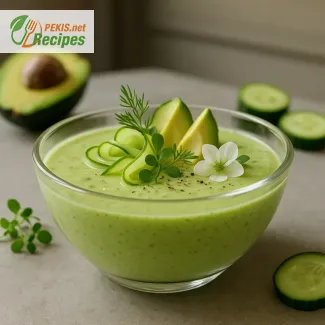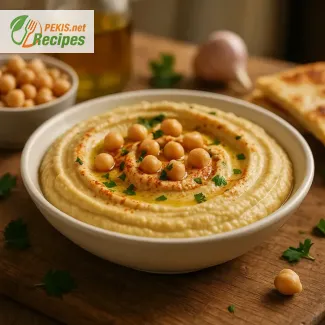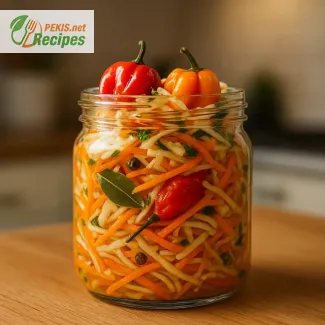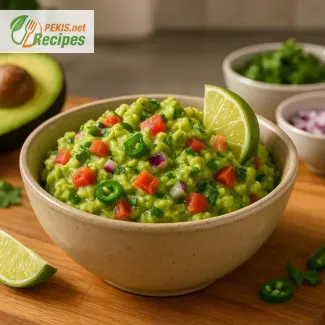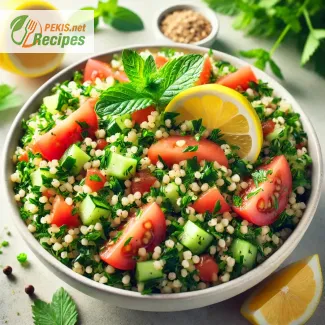
Tabbouleh is a vibrant, refreshing Lebanese salad that captures the essence of Mediterranean flavors and is cherished across the Middle East and Mediterranean regions. Known for its fresh and herb-forward profile, Tabbouleh is crafted from a simple yet flavorful combination of bulgur, parsley, mint, tomatoes, and a generous squeeze of lemon juice, creating a harmony of flavors and textures that is nothing short of captivating. Each ingredient in this dish serves a purpose, enhancing not only the taste but also the nutritional value, making Tabbouleh a go-to option for those seeking a healthy, light, and refreshing meal.
The foundation of Tabbouleh lies in bulgur, a nutty, slightly chewy grain that absorbs the flavors of lemon and olive oil beautifully. Bulgur is high in fiber, vitamins, and minerals, offering a nutritious base that contrasts perfectly with the brightness of fresh herbs. For those sensitive to gluten, bulgur can be easily replaced with quinoa, which also brings a protein-rich, gluten-free alternative to the dish, ensuring the Tabbouleh retains its signature texture and lightness.
Parsley is the heart and soul of Tabbouleh, adding not just a burst of green but a robust, slightly peppery flavor that sets this salad apart. Unlike other salads where parsley may be a garnish, in Tabbouleh, it is a main ingredient, finely chopped to provide both color and flavor. This nutrient-dense herb is loaded with Vitamin K and Vitamin C, essential for bone health and a strong immune system, respectively. When chopped finely, parsley releases its full flavor, blending effortlessly with the other ingredients.
Adding to the freshness is mint, a key component that gives Tabbouleh its unique cooling effect and aroma. Mint pairs beautifully with parsley, providing a gentle sweetness and a burst of aromatic complexity that heightens the overall experience. The combination of mint and lemon creates a zesty, invigorating profile that keeps this salad light and refreshing, ideal for warm days or as an accompaniment to richer dishes.
Tomatoes bring a juicy, tangy sweetness that balances the herbaceousness of parsley and mint. When diced finely, the tomatoes integrate seamlessly with the other ingredients, allowing their natural juices to mingle with the lemon and olive oil dressing. Rich in Vitamin C and lycopene, tomatoes add a nutritional boost and a vibrant color contrast, making the dish visually appealing and nourishing. The texture of the tomatoes also provides a subtle juiciness, enhancing the overall mouthfeel and making each bite a satisfying experience.
Finally, lemon juice ties all these flavors together. The citrusy acidity of fresh lemon juice elevates Tabbouleh, acting as both a flavor enhancer and a natural preservative that keeps the salad fresh and bright. The lemon’s zesty, tangy notes awaken the taste buds and provide a lively contrast to the richness of the olive oil. A high-quality, cold-pressed extra virgin olive oil adds depth and silkiness, infusing the salad with a subtle fruity flavor that complements the zesty herbs and citrus.
The beauty of Tabbouleh lies in its versatility. While traditionally served as a side dish, it is often enjoyed as the centerpiece of a light meal, especially when paired with warm pita, hummus, or falafel. Its refreshing qualities make it a popular choice for outdoor gatherings, picnics, and shared meals, where its vibrant flavors and wholesome ingredients can be appreciated by all.
Tabbouleh is more than just a salad; it is a celebration of fresh, natural ingredients that are as visually appealing as they are delicious. The combination of herbs, grains, and vegetables offers a powerful blend of antioxidants and nutrients that support overall health, making Tabbouleh not only a flavorful dish but also a superfood-rich option. Whether you are looking for a vegan, gluten-free, or low-fat choice, Tabbouleh can be adapted to meet your dietary needs without compromising on flavor or satisfaction.
In addition to its health benefits, Tabbouleh also holds cultural significance in Lebanese and Mediterranean cuisines. It symbolizes the region’s love for seasonal, wholesome ingredients and the art of creating flavor from simple, fresh produce. By enjoying Tabbouleh, you are savoring a part of Mediterranean culinary heritage, a tradition rooted in both flavor and wellness.
- Prepare Bulgur: Soak the bulgur in boiling water for 10 minutes or until soft, then drain excess water.
- Chop Herbs and Vegetables: Finely chop the parsley and mint, and dice the tomatoes and cucumber.
- Combine Ingredients: In a large bowl, mix the bulgur, parsley, mint, tomatoes, and cucumber.
- Season and Dress: Add lemon juice, olive oil, salt, and pepper. Toss well to combine.
- Serve: Chill for 15 minutes before serving to allow flavors to blend.
Creating the perfect Tabbouleh is as much about technique and balance as it is about high-quality, fresh ingredients. This Lebanese salad can be adapted in various ways to suit dietary needs, taste preferences, and even seasonal availability. Here are some professional tips to enhance the flavors, texture, and nutritional profile of Tabbouleh, making it even more appealing for diverse palates.
1. Choosing the Bulgur: Adjusting Texture and Flavor
- Bulgur Selection: Bulgur, a staple in traditional Tabbouleh, varies in coarseness. Fine or medium-coarse bulgur is preferred for a more traditional Lebanese version as it absorbs flavors quickly, blending well with the herbs without overwhelming them. For a nuttier flavor and a chewier texture, opt for a coarser grind, but ensure it is fully softened before mixing.
- Gluten-Free Alternative: To make Tabbouleh suitable for gluten-intolerant individuals, quinoa is an excellent substitute. Light, fluffy, and protein-rich, quinoa has a similar texture to bulgur and can be prepared by simmering until tender. It absorbs flavors well and brings a subtle, nutty taste to the salad.
2. Enhancing the Freshness of Herbs
- Parsley: Flat-leaf parsley is essential for Tabbouleh, as its robust flavor and sturdy leaves withstand chopping without losing texture. Chop the parsley finely and evenly; it’s best to wash and thoroughly dry the parsley before chopping, as excess moisture can make the salad soggy.
- Mint: Fresh mint adds an aromatic freshness to Tabbouleh. Be sure to use tender, young mint leaves, as older leaves can be more bitter. To keep the mint vibrant, add it just before serving, and avoid over-chopping to retain its essential oils and flavor.
3. Perfecting the Tomatoes
- Seasonality Matters: Tabbouleh relies on the juicy sweetness of ripe tomatoes. Using seasonal, vine-ripened tomatoes is ideal. If only larger varieties are available, remove the seeds and any excess liquid before dicing. This step prevents the salad from becoming watery and maintains the consistency of the other ingredients.
- Options for Added Flavor: Heirloom tomatoes add a complex sweetness and color variation to the dish, while cherry or grape tomatoes bring a concentrated burst of flavor and a slightly different texture.
4. Lemon Juice: Adjusting Acidity for Balance
- Quality and Freshness: Fresh lemon juice is critical to achieving the bright acidity that characterizes Tabbouleh. Using a hand-squeezed lemon prevents any bitterness that can come from using store-bought juices.
- Balancing with Sweetness: While Tabbouleh traditionally has a tart flavor profile, a touch of natural sweetener, like honey or a pinch of sugar, can be added to mellow the sharpness of the lemon juice without overpowering the other ingredients. This small tweak can make the salad more approachable for those sensitive to acidity.
5. Adding Depth with Olive Oil
- Choosing High-Quality Extra Virgin Olive Oil: The olive oil used in Tabbouleh should be fresh, cold-pressed extra virgin olive oil. Its peppery, fruity notes are essential for the salad’s depth of flavor. Drizzling a small amount just before serving can enhance the aroma and give the Tabbouleh a beautiful gloss.
- Infused Oils for Variation: For an extra layer of flavor, consider infusing the olive oil with garlic or lemon zest. Simply warm the olive oil with a crushed garlic clove or lemon peel, let it cool, and drizzle over the salad before serving. This adds complexity without overpowering the freshness of the herbs.
6. Alternative Vegetables for Texture and Flavor
- Adding Cucumbers: Although cucumber isn’t a traditional ingredient in Tabbouleh, adding diced cucumber can give the salad a refreshing crunch. Persian or English cucumbers work well because they have a mild flavor and fewer seeds.
- Including Radishes: For a subtle peppery bite, try adding thinly sliced radishes. Their crisp texture and slight spiciness complement the herbs and citrus, giving the salad a more complex flavor.
7. Seasoning Techniques for Optimal Flavor
- Salt and Pepper: The balance of salt and pepper is key to bringing out the flavors in Tabbouleh. Seasoning lightly at first, then adjusting after the salad has had time to marinate, ensures that the flavors are not overly salted.
- Sumac for a Tart Twist: Adding a sprinkle of sumac, a Middle Eastern spice with a tart, lemony flavor, can elevate the traditional lemony taste of Tabbouleh. Sumac pairs well with the herbs and provides a richer, more complex acidity.
8. Letting the Salad Marinate
- Marinating Time: Allowing Tabbouleh to sit for 15-30 minutes before serving helps the flavors meld and enhances the taste. Bulgur and herbs absorb the olive oil, lemon juice, and seasonings, creating a more cohesive flavor profile.
- Serving Temperature: Serve Tabbouleh slightly chilled or at room temperature. This temperature brings out the freshness of the herbs and allows the bulgur to fully integrate with the dressing. Over-chilling can dull the flavor, so avoid refrigerating the salad for too long before serving.
9. Adding Proteins for a Heartier Meal
- Chickpeas: Adding chickpeas is a great way to transform Tabbouleh into a more substantial meal. They bring a creamy texture and extra protein, making the salad filling and suitable as a main dish.
- Grilled Chicken or Feta: For a non-traditional but flavorful variation, add small pieces of grilled chicken or crumbled feta cheese. Both options add a savory depth and increase the protein content.
10. Health and Nutritional Tweaks
- Reducing Sodium: To lower sodium, use a reduced amount of salt or substitute with a salt-free seasoning blend, which can add flavor without the extra sodium.
- Increasing Fiber and Nutrients: Mixing in other grains, like farro or barley, with the bulgur can increase fiber and nutritional diversity. Ensure any additional grains are prepared according to package instructions for proper texture.
- Adding Microgreens: For extra vitamins and antioxidants, sprinkle some microgreens, such as radish or pea shoots, on top of the salad. These small greens are nutrient-dense and add a slight crunch.
11. Presentation Tips for Visual Appeal
- Lemon Garnishes: Garnishing with thin lemon slices or wedges around the edge of the serving bowl not only adds a pop of color but also allows diners to add extra lemon juice if desired.
- Herb Sprigs for Freshness: Finish the salad with a few sprigs of fresh parsley or mint on top for a professional, inviting presentation. This little touch highlights the freshness and quality of the ingredients.
- Serve with Pita Bread or Lettuce Wraps: Serve Tabbouleh with warm pita bread or crisp lettuce leaves to enhance the meal. Lettuce wraps provide a refreshing, low-calorie alternative to bread and make the dish suitable for gluten-free diets.
12. Adjusting for Dietary Needs
- Vegetarian and Vegan-Friendly: Tabbouleh is naturally vegetarian and vegan, making it a versatile option for various dietary preferences. To ensure it’s suitable for everyone, always check that any added ingredients, such as honey or cheese, align with dietary requirements.
- Low-Fat Variation: For a lighter version, reduce the olive oil slightly. Lemon juice alone can provide enough moisture and flavor, and reducing oil will lower the calorie content without sacrificing taste.
These adjustments to the classic Tabbouleh recipe make it adaptable, flavorful, and well-suited to any meal. Whether you’re looking to create a light, refreshing salad or a more robust, protein-rich dish, these tips enhance the flavor, texture, and presentation of Tabbouleh for a memorable dining experience.
- Gluten: Bulgur contains gluten. For a gluten-free alternative, substitute bulgur with cooked quinoa.
- Allergens: None typical, though verify ingredients for cross-contamination risks.
- Vitamin C (70 mg): Boosts immunity, supports skin health.
- Vitamin K (100 μg): Essential for bone health and blood clotting.
- Folate (50 μg): Important for cell division, particularly for pregnant individuals.
- Iron (1.2 mg): Supports red blood cell production and oxygen transport.
- Potassium (200 mg): Regulates blood pressure and muscle function.
- Lycopene from Tomatoes (5 mg):
- Protects against oxidative stress.
- May reduce risk of certain cancers.
- Vitamin C in Parsley and Lemon Juice:
- Shields cells from free radicals.
- Strengthens immune function and skin resilience

